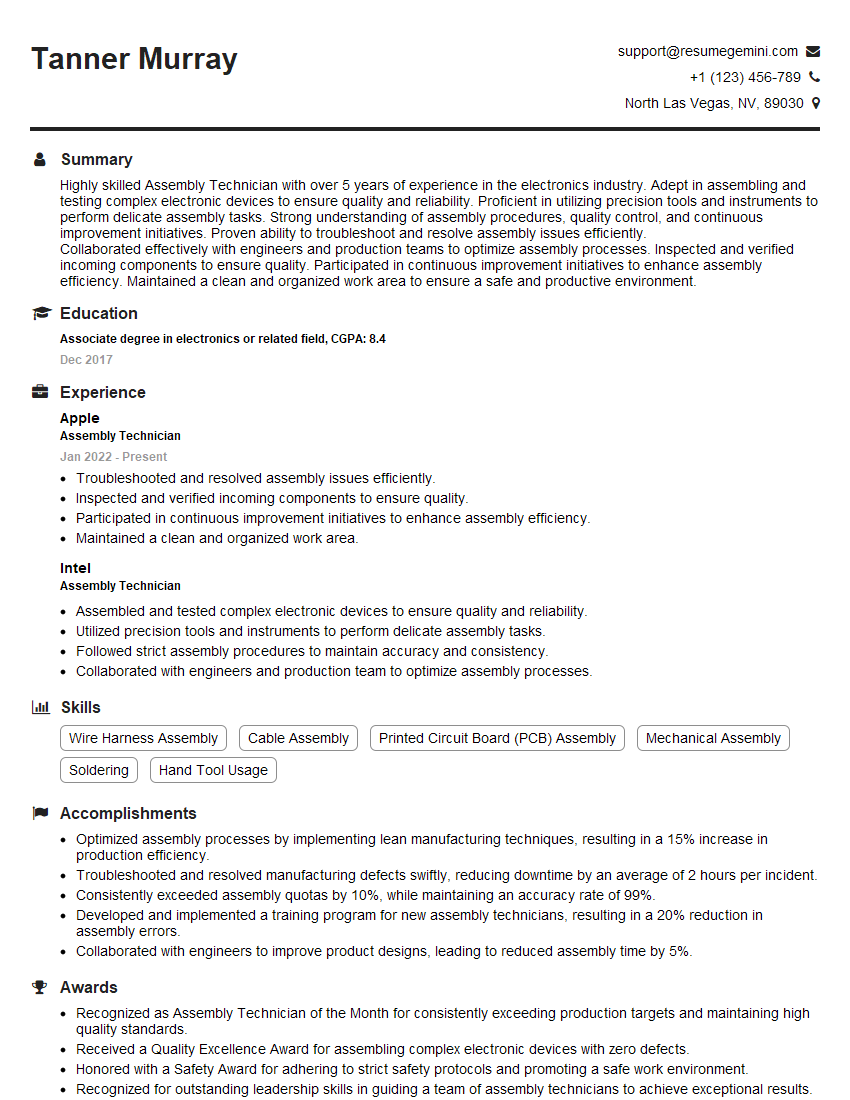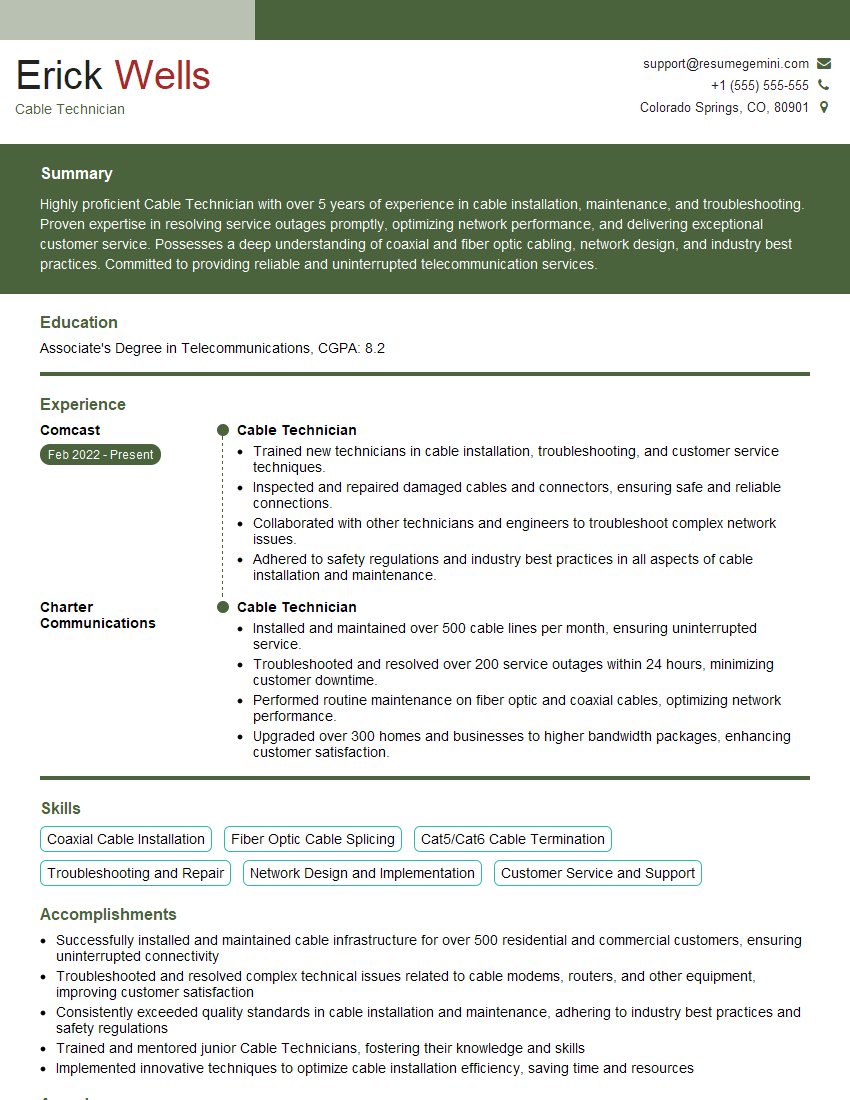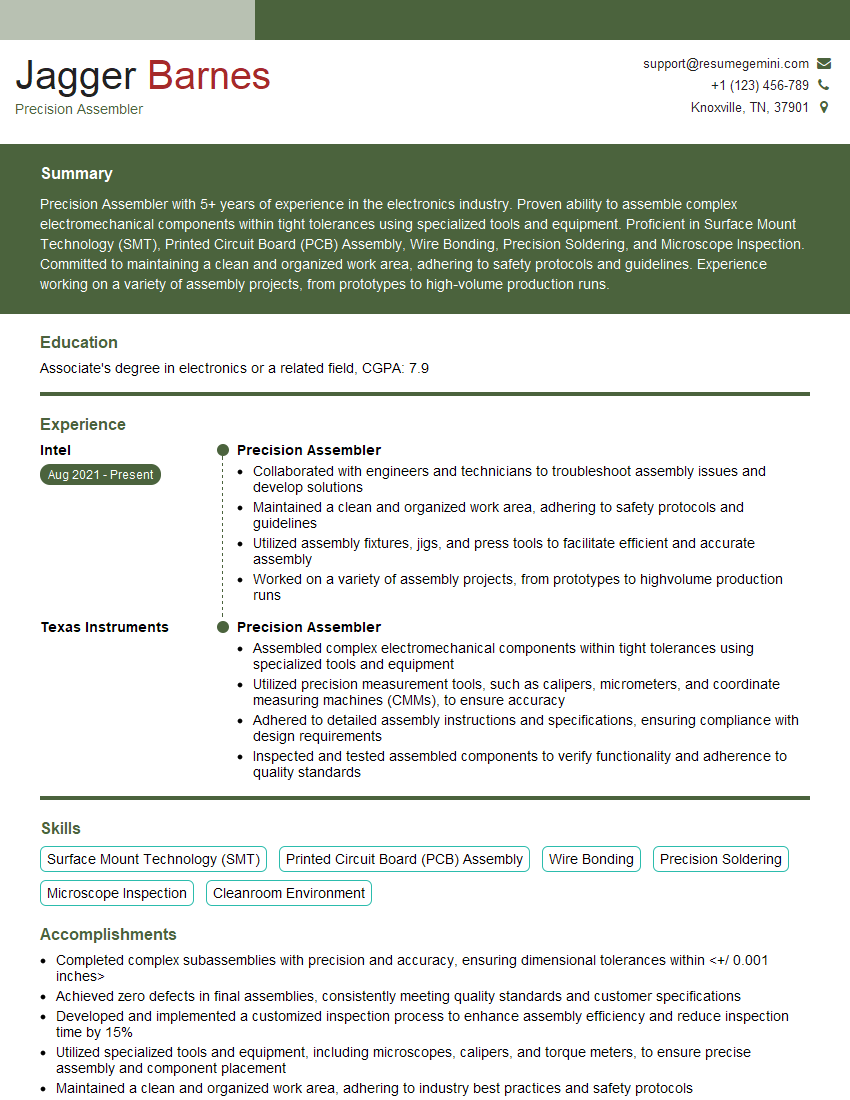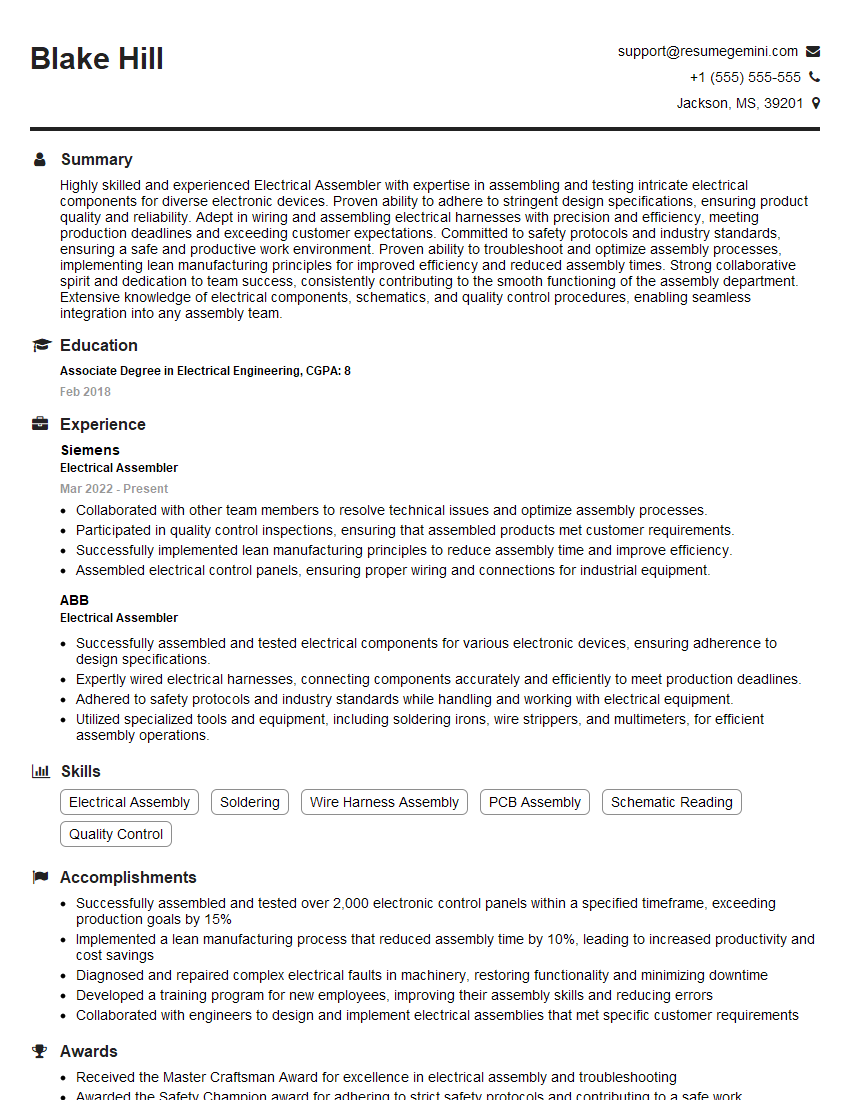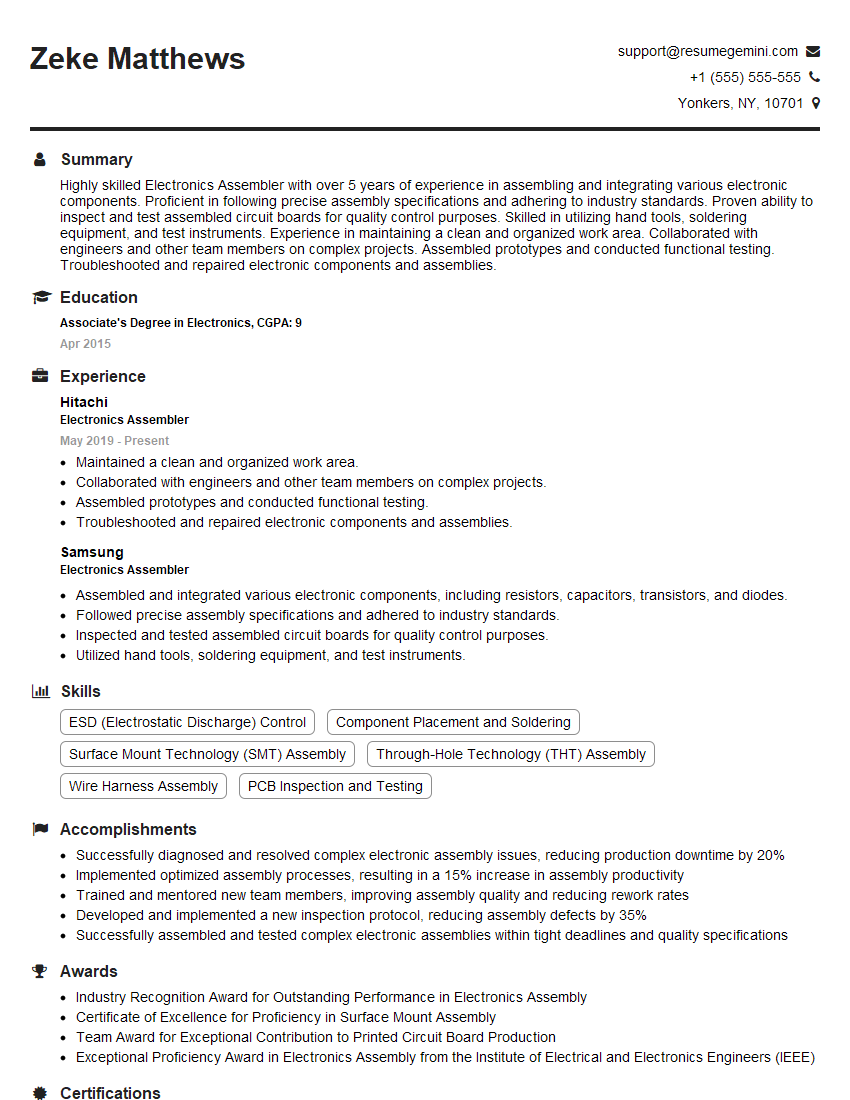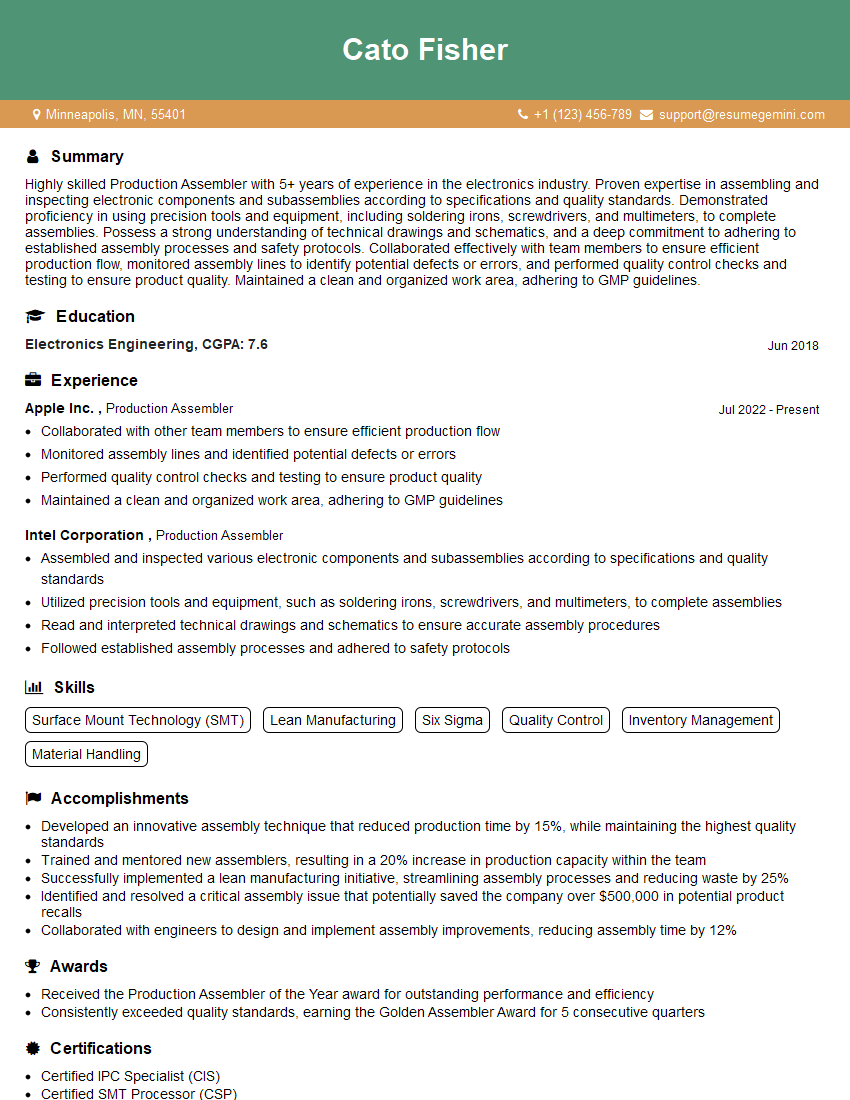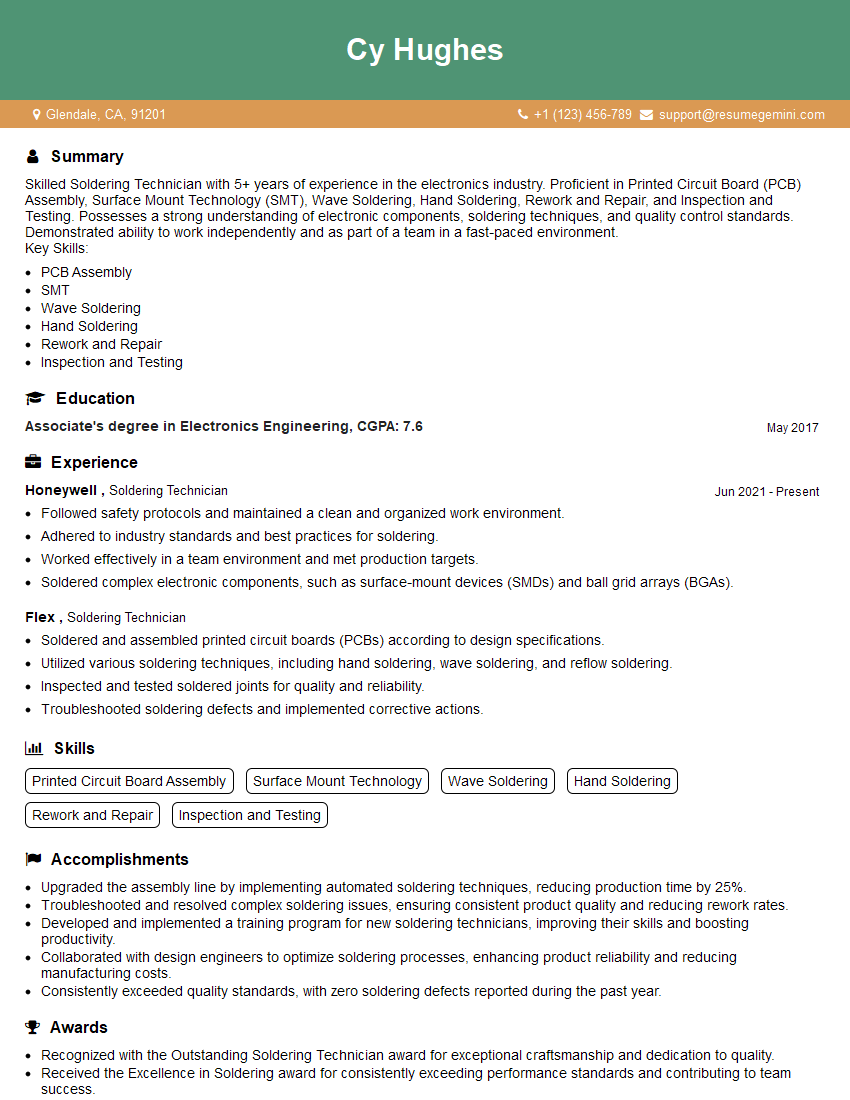Cracking a skill-specific interview, like one for Cable and Connector Assembly, requires understanding the nuances of the role. In this blog, we present the questions you’re most likely to encounter, along with insights into how to answer them effectively. Let’s ensure you’re ready to make a strong impression.
Questions Asked in Cable and Connector Assembly Interview
Q 1. Explain the different types of cable connectors and their applications.
Cable connectors are the crucial interface points for transferring signals and power. They come in a vast array of types, each tailored to specific applications. The choice depends on factors like the cable type, signal frequency, power requirements, environmental conditions, and the ease of connection.
- RJ45 (Registered Jack 45): Commonly used for Ethernet networking, these connectors utilize eight individual conductors arranged in a specific pattern for data transmission.
- USB (Universal Serial Bus): A ubiquitous standard for data and power transfer, USB connectors are available in various sizes and versions (Type-A, Type-B, Type-C, Micro-B, Mini-B), each offering different data rates and power capabilities.
- HDMI (High-Definition Multimedia Interface): Primarily employed for high-definition audio and video transmission, HDMI connectors provide both digital and analog signal transfer in a single cable.
- BNC (Bayonet Neill-Concelman): Used in coaxial cable applications for radio frequency (RF) signals, BNC connectors provide a secure, quick-connect mechanism with a bayonet locking system. They are commonly seen in telecommunications and instrumentation.
- D-Subminiature (D-Sub): These connectors are known for their rectangular shape and multiple pin configurations. They are utilized in various applications, including computer monitors, serial communication, and industrial control systems.
- Circular Connectors (e.g., MIL-C-5015, MIL-DTL-38999): Robust connectors often employed in harsh environments like aerospace and defense, characterized by their high durability and reliability.
Choosing the correct connector is paramount; using the wrong type can result in signal degradation, connectivity issues, and potential damage to equipment.
Q 2. Describe the process of crimping a connector onto a wire.
Crimping a connector onto a wire involves securely attaching the connector to the wire using a specialized crimping tool. It’s a crucial step, as a poorly crimped connection can lead to signal loss, intermittent connectivity, or complete failure. Here’s a step-by-step process:
- Prepare the Wire: Strip the wire insulation to the appropriate length specified by the connector manufacturer. Use a wire stripper designed for the wire gauge to ensure a clean, even strip, avoiding damage to the conductor.
- Insert the Wire: Carefully insert the stripped wire into the connector, ensuring that it fully penetrates the terminal or crimp area. The wire strands should be straight and free of kinks.
- Position the Connector: Place the connector in the crimping tool, ensuring proper alignment with the crimp jaws. Incorrect placement can result in a poorly formed crimp and a weak connection.
- Crimp the Connector: Squeeze the crimping tool handles firmly and completely. Do not release until the tool has completely cycled. The crimp should be firm and consistent, without crushing the wire.
- Inspect the Crimp: After crimping, visually inspect the connection. The crimp should be a uniform, solid shape, with no visible gaps or deformities. A poorly formed crimp is usually apparent.
Crimping tools vary based on the connector type and wire gauge, so it’s crucial to use the correct tool for the job. Using an incorrect tool or improper technique will result in a poor connection, leading to connector failure.
Q 3. What are the common causes of cable assembly failures?
Cable assembly failures can stem from various causes, often interconnected. Understanding these root causes is critical for improving reliability and preventing future problems.
- Poor Crimping: Insufficient or uneven crimps are a leading cause, leading to intermittent connectivity or complete disconnections.
- Improper Stripping: Damaging the wire conductors during stripping can cause signal degradation or complete breaks.
- Environmental Factors: Exposure to extreme temperatures, moisture, vibration, or chemicals can degrade the cable insulation, connectors, and solder joints.
- Incorrect Connector Selection: Choosing a connector unsuitable for the application can lead to signal attenuation, mechanical stress, and eventual failure.
- Strain Relief Issues: Lack of proper strain relief can cause undue stress on the cable near the connector, leading to wire breakage or connector detachment.
- Material Degradation: Over time, materials such as insulation, connectors, and solder can degrade, becoming brittle or losing their conductive properties.
- Manufacturing Defects: Faulty components or improper manufacturing processes can lead to weak points in the cable assembly.
Troubleshooting cable assembly failures often involves systematic investigation, starting with visual inspection, followed by signal testing and finally, analysis of the failed components.
Q 4. How do you ensure the quality of a cable assembly?
Ensuring quality in cable assembly involves a multi-faceted approach, incorporating quality control measures throughout the entire process.
- Component Inspection: Thorough inspection of all incoming components—cables, connectors, and other materials—for defects or damage.
- Process Control: Following strict manufacturing procedures and using calibrated tools to ensure consistency and accuracy in each step, from wire stripping and crimping to testing and packaging.
- Visual Inspection: Careful visual inspection of each assembled cable for proper crimps, strain relief, and overall integrity.
- Electrical Testing: Rigorous electrical testing to verify signal integrity, continuity, insulation resistance, and other relevant parameters.
- Environmental Testing: Testing cable assemblies under various environmental conditions (temperature, humidity, vibration) to ensure they meet required performance standards.
- Documentation: Maintaining detailed records of each step in the assembly process, including component traceability, test results, and any deviations.
Implementing a robust quality management system, such as ISO 9001, ensures a systematic approach to quality control and helps prevent failures.
Q 5. What safety precautions should be taken when working with cable assemblies?
Working with cable assemblies necessitates careful attention to safety to prevent injury or damage to equipment.
- Eye Protection: Always wear appropriate eye protection to shield against flying debris during stripping and crimping.
- Hand Protection: Use gloves to protect hands from sharp edges and potential cuts from wire or connector components.
- Tool Safety: Ensure crimping tools are in good working order and used correctly according to manufacturer instructions.
- Electrical Safety: Take precautions to avoid electrical shock, especially when working with live circuits. Always disconnect power before working on any cable assembly connected to energized equipment.
- Proper Workspace: Maintain a clean and organized workspace to prevent accidental injuries or damage to components.
- Static Electricity Control: Use appropriate grounding techniques to prevent static discharge from damaging sensitive electronic components.
Following established safety procedures is paramount to prevent accidents and maintain a safe working environment.
Q 6. Explain the importance of proper wire stripping techniques.
Proper wire stripping techniques are crucial for creating reliable and safe cable assemblies. Improper stripping can damage the wire conductors, leading to poor connectivity, signal degradation, and even short circuits.
The goals of proper wire stripping are to:
- Remove insulation without damaging the conductors: A clean strip avoids exposing individual strands, nicking the conductor or causing excessive fraying, ensuring optimal electrical contact within the connector.
- Maintain consistent strip length: This ensures the wire is correctly inserted into the connector terminal, creating a secure and reliable crimp.
- Minimize wire damage: A damaged conductor can result in increased resistance, weakened connectivity, and failure.
Using the right wire stripper for the wire gauge is vital. A poorly chosen tool can cause crushing, cutting, or excessive stripping of the wire insulation, leading to failure. It’s also crucial to follow the manufacturer’s instructions for the connector regarding the correct stripping length.
Q 7. What are the different types of cable shielding and their purposes?
Cable shielding protects the signal from electromagnetic interference (EMI) and radio frequency interference (RFI), maintaining signal integrity and preventing data corruption. Various types of shielding cater to different applications and levels of protection.
- Braided Shielding: A flexible metallic braid woven around the cable core. It offers good EMI/RFI protection and flexibility, suitable for many applications but may not offer the highest level of shielding effectiveness.
- Foil Shielding: A thin metallic foil layer wrapped around the cable. It provides excellent shielding effectiveness at higher frequencies but can be less flexible than braided shielding.
- Combined Shielding (Braid over Foil or Foil over Braid): Combines the advantages of both braided and foil shielding, offering superior EMI/RFI protection and a balance of flexibility and effectiveness. This is a common choice for applications requiring high-performance shielding.
- Conductive Polymer Shielding: A more recent development, this shielding uses a conductive polymer material. It offers good EMI/RFI rejection, flexibility, and lightweight properties but may not provide the same level of shielding as metal shielding.
The choice of shielding depends on the application’s susceptibility to EMI/RFI and the required flexibility and performance level. In high-noise environments, combined shielding or specialized solutions are often preferred to ensure signal integrity.
Q 8. How do you troubleshoot a faulty cable assembly?
Troubleshooting a faulty cable assembly involves a systematic approach. Think of it like diagnosing a car problem – you need to isolate the issue before fixing it. I begin by visually inspecting the entire assembly for any obvious damage, such as broken wires, loose connectors, or signs of overheating. Then, I’d use a multimeter to check continuity and insulation resistance. This helps identify breaks in the conductors or shorts to the ground. If the problem isn’t immediately apparent, I’ll use a signal tracer to pinpoint the exact location of a fault, especially in complex assemblies. Finally, I’ll check the connectors for proper seating and ensure the correct termination method has been used.
For example, I once worked on a faulty network cable that wasn’t transmitting data. Visual inspection revealed nothing. However, using a multimeter, I discovered a break in one of the twisted pairs near the connector. Resoldering the connection resolved the issue. My approach always prioritizes safety and proper grounding to prevent electrical shocks.
Q 9. Describe your experience with different soldering techniques.
My soldering experience spans various techniques, each suited to different applications and cable types. I’m proficient in through-hole soldering, surface mount soldering, and wire wrapping. Through-hole soldering, often used with larger connectors, requires precision and control of the soldering iron to create a strong, reliable connection without damaging surrounding components. Surface mount soldering is crucial for smaller, densely packed connectors found in many modern devices. Here, a fine-tipped iron and appropriate solder paste are key to avoid bridging between adjacent solder pads. Finally, wire wrapping provides a mechanically robust and reliable connection, especially in high-vibration environments.
I regularly use different types of solder, such as rosin-core and lead-free, selecting the appropriate type based on the application’s requirements and regulations. For example, lead-free solder is preferred in environmentally sensitive applications due to its lower toxicity.
Q 10. What are the different types of cable terminations?
Cable terminations are the methods used to connect the conductors of a cable to a connector. The type of termination depends heavily on the cable type and application. Common types include:
- Crimping: Uses a crimping tool to securely fasten a connector onto the cable’s conductors. This is very common for RJ45 connectors (Ethernet) and various other connectors.
- Soldering: Involves soldering the conductors directly to the connector’s terminals, suitable for more robust connections or where crimping isn’t feasible.
- Welding: Used for high-current applications demanding exceptional conductivity and reliability. This is often used in power cabling.
- Splicing: Joining two separate cables together, often using specialized connectors or heat-shrink tubing.
Selecting the right termination is crucial for ensuring signal integrity and reliability. Incorrect termination can lead to signal loss, poor performance, or complete failure of the cable assembly.
Q 11. What is the significance of color coding in cable assembly?
Color coding in cable assemblies is vital for several reasons. It serves as a quick and easy way to identify individual conductors, significantly speeding up troubleshooting and assembly. Different colors correspond to specific signal or power lines, as defined by industry standards or internal company practices. This is especially crucial in complex assemblies with many wires. Without color coding, tracing individual conductors would be extremely time-consuming and error-prone.
For instance, in network cabling, color codes follow strict standards (TIA/EIA-568A or 568B) to ensure compatibility and correct wiring. Incorrect color coding can lead to network connectivity issues. Standards often include color-coded diagrams to help assembly and maintenance.
Q 12. How do you interpret cable assembly schematics and drawings?
Interpreting cable assembly schematics and drawings is a fundamental skill. These documents provide a visual representation of the cable’s construction, showing the number of conductors, their arrangement, the type of connectors used, and the color coding. I’m proficient in reading various types of schematics, including those using standard symbols and those specific to particular manufacturers.
I carefully examine the legend to understand the meaning of each symbol and color code. Then, I follow the drawing, tracing the path of each conductor from one end of the cable to the other. This allows me to accurately assemble the cable, ensuring the correct connections are made.
Q 13. What experience do you have with automated cable assembly equipment?
I possess extensive experience with automated cable assembly equipment. This includes working with automated wire cutting and stripping machines, automated crimping machines, and automated testing equipment. These machines dramatically increase efficiency and consistency compared to manual assembly, reducing human error and improving production throughput.
For example, I’ve been involved in setting up and programming automated crimping machines for high-volume production of network cables. This involved configuring the machine to handle specific connector types and wire gauges, ensuring optimal crimping force and consistent quality. Programming and troubleshooting these machines requires a good understanding of both mechanical and electrical systems. Regular maintenance and calibration are also crucial for maintaining accuracy and reliability.
Q 14. Explain the difference between coaxial and twisted-pair cables.
Coaxial and twisted-pair cables are two distinct types with different characteristics and applications. The key difference lies in their construction and how they handle electromagnetic interference (EMI).
Coaxial cables consist of a central conductor surrounded by an insulator, a metallic shield, and an outer jacket. This design provides excellent shielding against EMI, making them ideal for high-frequency applications like cable television and radio transmission where signal integrity is critical. Think of the shield as a protective layer keeping out unwanted noise.
Twisted-pair cables are composed of multiple pairs of insulated conductors twisted together. The twisting helps to cancel out EMI by inducing opposite currents in the wires. While not as effective at shielding as coaxial cables, twisted-pair cables are lighter, more flexible, and easier to manufacture, making them cost-effective for various applications, such as telephone lines and Ethernet networking. The twisting creates a balanced impedance, helping to reduce noise.
In essence, coaxial cables offer superior EMI protection, but twisted-pair cables are a versatile and more economical solution for many applications.
Q 15. Describe your experience with various connector types (e.g., RJ45, USB, BNC).
My experience encompasses a wide range of connector types, crucial for diverse applications. I’ve worked extensively with RJ45 connectors, the industry standard for Ethernet networking. I understand the intricacies of their 8P8C configuration, including T568A and T568B wiring schemes and the importance of proper crimping for reliable data transmission. With USB connectors, I’m familiar with various types, from the older A and B types to the more modern micro-USB, mini-USB, and USB-C, each with its own unique physical characteristics and data transfer capabilities. My experience also extends to BNC connectors, commonly used in coaxial cable applications for video and high-frequency signals. I’m adept at working with different impedance levels and ensuring proper termination to minimize signal loss and reflections. Beyond these, I have experience with other connectors like D-subminiature connectors, HDMI, and various power connectors, each requiring specific handling and assembly techniques.
Career Expert Tips:
- Ace those interviews! Prepare effectively by reviewing the Top 50 Most Common Interview Questions on ResumeGemini.
- Navigate your job search with confidence! Explore a wide range of Career Tips on ResumeGemini. Learn about common challenges and recommendations to overcome them.
- Craft the perfect resume! Master the Art of Resume Writing with ResumeGemini’s guide. Showcase your unique qualifications and achievements effectively.
- Don’t miss out on holiday savings! Build your dream resume with ResumeGemini’s ATS optimized templates.
Q 16. How do you manage inventory and ensure sufficient components for cable assembly?
Efficient inventory management is paramount in cable assembly. I utilize a combination of techniques. Firstly, I maintain a detailed bill of materials (BOM) for each cable assembly, specifying each component with its part number, quantity, and supplier. Secondly, I employ a robust inventory tracking system, either a dedicated software solution or a well-organized spreadsheet, to monitor stock levels in real-time. This allows for proactive ordering, preventing delays due to shortages. Regular cycle counting helps ensure accuracy and identify discrepancies. For critical components, I implement a buffer stock to mitigate against unexpected supply chain disruptions. Finally, I work closely with procurement to negotiate favorable terms with reliable suppliers, ensuring a steady flow of high-quality components.
Q 17. What is your experience with testing and inspection equipment for cable assemblies?
My experience with testing and inspection equipment is extensive. I’m proficient in using various tools, including cable testers (e.g., Fluke Networks certified testers) to verify continuity, wiremap, and signal attenuation. I also utilize time-domain reflectometers (TDRs) to pinpoint faults and impedance mismatches along cable runs. For high-speed applications, I utilize oscilloscopes and bit-error rate testers (BERTs) to assess signal integrity. Furthermore, I’m familiar with automated test equipment (ATE) for high-volume production environments, which significantly increases efficiency and consistency. Beyond electrical testing, I employ visual inspection tools like microscopes to ensure proper crimping, soldering, and overall cable assembly quality. All testing is meticulously documented to maintain traceability and quality control.
Q 18. Describe a time you had to troubleshoot a complex cable assembly problem.
I once faced a challenging situation involving a custom high-speed data cable assembly for a critical industrial application. After initial assembly, the system experienced intermittent data loss. Through systematic troubleshooting, I first used a cable tester to rule out continuity issues. Then, using a TDR, I identified a significant impedance mismatch approximately halfway along the cable. Further investigation revealed a poorly shielded section of the cable, causing signal reflections and data corruption. This highlighted the importance of quality control throughout the assembly process, particularly with high-speed applications. By carefully re-shielding that section and rerunning tests, I resolved the issue, ensuring the system’s stability and reliability. This experience taught me the value of methodical troubleshooting, starting with basic tests before progressing to more advanced techniques.
Q 19. What is your understanding of IPC standards related to cable and connector assembly?
My understanding of IPC standards, particularly IPC-A-620 (for cable and wiring harness assemblies) and IPC-J-STD-001 (for soldering), is crucial for maintaining consistent quality. IPC-A-620 provides detailed acceptance criteria for workmanship, covering aspects like wire preparation, termination, marking, and overall assembly quality. Understanding its acceptance criteria ensures the produced cable assemblies meet the required performance and reliability standards. Similarly, IPC-J-STD-001 guides soldering techniques, critical for robust and reliable connections. I use these standards as benchmarks to ensure our processes are efficient and produce high-quality, reliable assemblies.
Q 20. How do you handle discrepancies between assembly instructions and actual components?
Discrepancies between assembly instructions and actual components require immediate attention. My first step is to carefully review both the instructions and the components, verifying part numbers and specifications. If a discrepancy is confirmed, I immediately escalate the issue to the engineering team, providing photographic evidence and detailed documentation. This ensures that the correct components are identified and any necessary design changes are implemented. In the meantime, I’ll flag the affected assembly as non-compliant and put it aside until the issue is resolved. Communication is key to maintaining the integrity of the process.
Q 21. Explain your experience with different types of wire insulation.
My experience with wire insulation encompasses various types, each chosen based on the application’s specific needs. I’m familiar with PVC (polyvinyl chloride) insulation, a common and cost-effective choice for general-purpose applications. For higher temperature applications, I use materials like silicone or Teflon. In applications requiring enhanced flexibility, I often work with polyurethane or polyethylene. For high-voltage applications, specialized insulation with high dielectric strength is critical. Furthermore, I’m aware of the environmental considerations and regulatory compliance associated with different insulation materials, such as RoHS compliance. Selecting the right insulation is paramount to ensure the cable assembly meets its performance and safety requirements.
Q 22. What is your experience with cable lacing and harnessing techniques?
Cable lacing and harnessing are crucial for organizing and protecting wire bundles in cable assemblies. Think of it like neatly organizing the cords behind your entertainment center – except these cables might power a critical system! My experience encompasses various techniques, including:
- Parallel Lacing: This involves arranging cables parallel to each other and securing them with lacing cord at regular intervals. It’s ideal for smaller bundles and provides a clean, organized look.
- Spiral Wrapping: This method involves wrapping the lacing cord around the cable bundle in a spiral pattern. It’s more robust than parallel lacing and is excellent for larger bundles or applications requiring greater protection against vibration and movement.
- Harnessing with Cable Ties: Using various types of cable ties (Nylon, Velcro straps, etc.) for securing cable bundles, often in conjunction with lacing. This is frequently used for quick assembly and in locations requiring easy access for maintenance.
- Pre-formed Harnesses: Working with pre-manufactured cable harnesses, requiring precise assembly and connection to specified terminals or connectors. This requires careful attention to detail and is essential for larger, complex systems.
I’ve worked on projects ranging from simple appliance wiring to complex aerospace harnesses, adapting my techniques to the specific requirements of each project. For instance, in automotive applications, I utilize flame-retardant ties and sleeving to meet safety standards.
Q 23. How do you maintain a clean and organized workspace during cable assembly?
A clean and organized workspace is paramount for efficient and error-free cable assembly. It’s about more than just aesthetics; it directly impacts productivity and quality. My approach includes:
- Designated work areas: Separating areas for different assembly stages (e.g., cutting, stripping, crimping, lacing).
- Component organization: Using bins, trays, and labels to keep components sorted and easily accessible. Think of it like a well-stocked toolbox – you know exactly where to find what you need.
- Regular cleanup: Removing excess wire scraps, tools, and packaging materials throughout the assembly process to maintain a clutter-free environment.
- Anti-static mats: Implementing ESD protection measures, including anti-static mats and wrist straps, to prevent damage from static electricity.
- Visual aids: Using assembly diagrams and checklists to ensure components and steps are followed accurately.
By following these practices, I ensure a smooth workflow, minimizing the risk of errors and rework, and making it easier to troubleshoot any issues that may arise.
Q 24. Describe your experience with different types of adhesives and their applications in cable assembly.
Adhesives play a critical role in securing components and providing environmental protection in cable assemblies. My experience spans several types:
- Hot melt adhesives: Used for quickly bonding components, but requiring careful application to avoid excess glue or damage to components. Excellent for situations needing immediate strength.
- Epoxy adhesives: Offer high strength and durability, ideal for applications demanding long-term stability and resistance to environmental factors. Curing time needs to be considered.
- Acrylic adhesives: Versatile adhesives that cure quickly and are relatively easy to apply, often used for less demanding applications.
- Silicone adhesives: Known for their flexibility and resistance to high and low temperatures, often used in applications with extreme temperature fluctuations.
Selecting the appropriate adhesive depends on several factors, including the materials being bonded, environmental conditions, and required strength. For example, I’d use a high-temperature silicone adhesive for an aerospace application where the assembly might experience extreme temperature changes.
Q 25. What software or tools are you familiar with for designing or managing cable assemblies?
I’m proficient in several software tools used in cable assembly design and management. These include:
- Autodesk Inventor/SolidWorks: For 3D modeling of cable assemblies and harness layouts. This allows for accurate visualization and planning before physical assembly.
- CAD software (various): For creating detailed drawings and schematics, essential for communication and documentation.
- Harness design software: Specialized software packages for creating and managing complex cable harness designs, including automatic routing and component selection features.
- Spreadsheet software (e.g., Excel, Google Sheets): For managing bill of materials (BOMs), tracking components, and organizing assembly data. This ensures accurate procurement and assembly.
Proficiency in these tools ensures efficient design, accurate documentation, and streamlined manufacturing processes. For example, using 3D modeling software lets me identify and resolve potential interference issues early in the design phase, saving time and resources.
Q 26. Explain your understanding of ESD (Electrostatic Discharge) protection and its importance in cable assembly.
ESD (Electrostatic Discharge) protection is crucial in cable assembly, as static electricity can damage sensitive electronic components. Even a small discharge can cause malfunctions or permanent damage. My understanding of ESD protection involves:
- ESD-safe workspaces: Using anti-static mats, wrist straps, and other grounding equipment to dissipate static charges.
- ESD-safe packaging: Using anti-static bags and containers for storing and transporting sensitive components.
- Proper handling techniques: Avoiding rapid movements and maintaining contact with grounded surfaces while working with sensitive components.
- Regular testing of equipment: Ensuring that grounding equipment is functioning correctly.
I meticulously follow ESD protocols throughout the entire assembly process to prevent damage and ensure the reliability of the final product. Ignoring ESD precautions can lead to costly repairs or complete assembly failure. Imagine the consequences of a static discharge frying a circuit board in a critical aerospace system!
Q 27. How do you ensure the durability and longevity of a cable assembly?
Ensuring the durability and longevity of a cable assembly requires careful attention to detail throughout the entire process. Key aspects include:
- Material selection: Choosing high-quality, durable materials such as stranded conductors for flexibility and strain relief, and appropriate jacketing for environmental protection.
- Proper crimping techniques: Using the correct crimping tools and dies to ensure secure and reliable connections, preventing wire breakage or connector failure.
- Strain relief: Implementing effective strain relief measures to protect connection points from stress and prevent wire breakage, such as using heat shrink tubing or strain relief boots.
- Environmental protection: Using appropriate jacketing or sleeving to protect the cables from abrasion, moisture, chemicals, and other environmental factors.
- Testing and inspection: Conducting thorough testing and inspection to identify and address potential issues before the assembly is deployed. This could include visual inspection, continuity testing, and high-potential testing.
By paying close attention to these details, I can ensure the cable assemblies I produce can withstand the rigors of their intended application and provide reliable service for years to come. Neglecting these steps can lead to premature failure and costly downtime.
Q 28. Describe your experience with different types of cable connectors used in specific industries (e.g., automotive, aerospace).
My experience with various cable connectors spans multiple industries. Here are some examples:
- Automotive: I’ve worked extensively with Deutsch connectors (DT, HD), AMP connectors, and various automotive-specific sealed connectors. These connectors need to be robust and resistant to vibration, temperature fluctuations, and exposure to fluids.
- Aerospace: My experience includes working with MIL-SPEC connectors such as Cannon, TE Connectivity, and Amphenol connectors. These connectors require rigorous testing and certification to ensure reliability in demanding environments.
- Industrial Automation: I’m familiar with a wide variety of industrial connectors, including M12, RJ45, and various industrial-grade circular connectors. These need to be durable and easy to disconnect for maintenance.
- Telecommunications: Extensive experience with various coaxial connectors (e.g., BNC, F-type, SMA) and fiber optic connectors. These demand precision and minimal signal loss.
Connector selection is critical and depends heavily on the specific requirements of the application. For example, in aerospace, the connectors must meet stringent standards for reliability and safety in demanding environmental conditions.
Key Topics to Learn for Cable and Connector Assembly Interview
- Connector Types and Applications: Understanding various connector types (e.g., RJ45, USB, BNC, etc.), their specifications, and appropriate applications in different industries (telecommunications, automotive, aerospace, etc.). Consider the advantages and disadvantages of each type.
- Cable Construction and Properties: Familiarize yourself with different cable types (coaxial, twisted-pair, fiber optic), their construction materials, and how these properties impact signal transmission, impedance matching, and overall performance. Be prepared to discuss shielding and grounding techniques.
- Assembly Techniques and Processes: Mastering crimping, soldering, and other assembly techniques. Understand quality control procedures, including testing and inspection methods to ensure reliable connections. Discuss the importance of proper tooling and safety precautions.
- Troubleshooting and Diagnostics: Develop your ability to diagnose common cable and connector assembly issues. Be prepared to discuss methods for identifying faulty connections, shorts, opens, and signal degradation. Knowing how to use testing equipment (multimeters, oscilloscopes) is crucial.
- Industry Standards and Regulations: Understand relevant industry standards and regulations (e.g., IPC standards) that govern cable and connector assembly. This demonstrates your commitment to quality and compliance.
- Materials Science and Properties: Understanding the properties of different materials used in cable and connector assembly (conductors, insulators, dielectrics) and how these properties affect performance and durability.
- Production Processes and Efficiency: Familiarize yourself with lean manufacturing principles and techniques for optimizing cable and connector assembly processes. Discuss strategies for improving efficiency and reducing waste.
Next Steps
Mastering Cable and Connector Assembly opens doors to diverse and rewarding career opportunities in a rapidly growing technological landscape. Proficiency in this field demonstrates a strong foundation in practical skills and technical understanding highly valued by employers. To significantly enhance your job prospects, create an ATS-friendly resume that highlights your skills and experience effectively. ResumeGemini is a trusted resource to help you build a professional and impactful resume. We offer examples of resumes tailored specifically to the Cable and Connector Assembly field to guide you in crafting your application materials.
Explore more articles
Users Rating of Our Blogs
Share Your Experience
We value your feedback! Please rate our content and share your thoughts (optional).
What Readers Say About Our Blog
Dear Sir/Madam,
Do you want to become a vendor/supplier/service provider of Delta Air Lines, Inc.? We are looking for a reliable, innovative and fair partner for 2025/2026 series tender projects, tasks and contracts. Kindly indicate your interest by requesting a pre-qualification questionnaire. With this information, we will analyze whether you meet the minimum requirements to collaborate with us.
Best regards,
Carey Richardson
V.P. – Corporate Audit and Enterprise Risk Management
Delta Air Lines Inc
Group Procurement & Contracts Center
1030 Delta Boulevard,
Atlanta, GA 30354-1989
United States
+1(470) 982-2456

